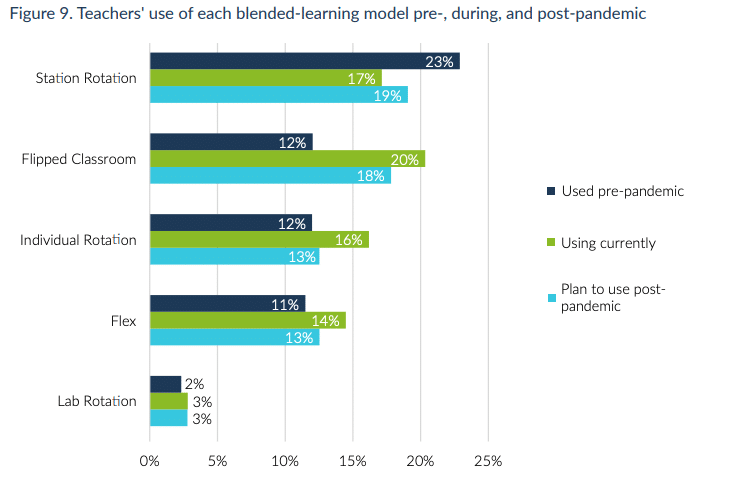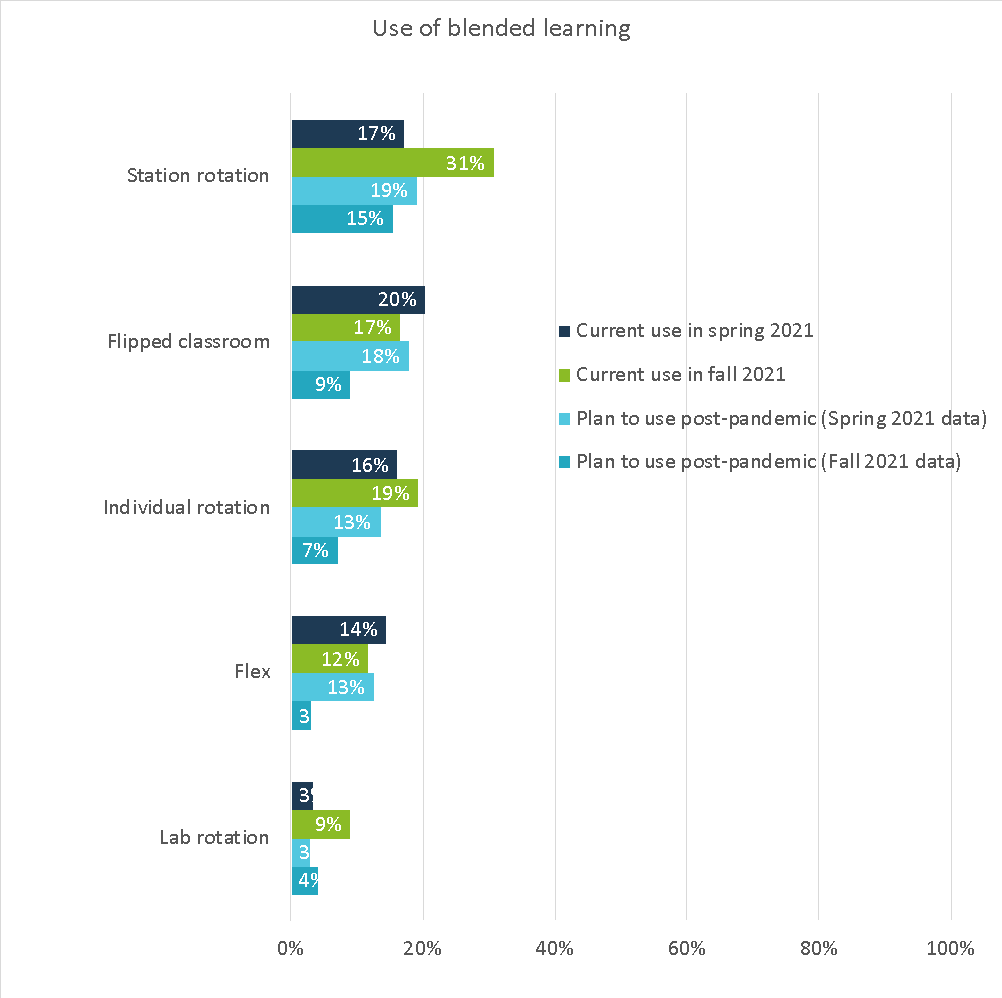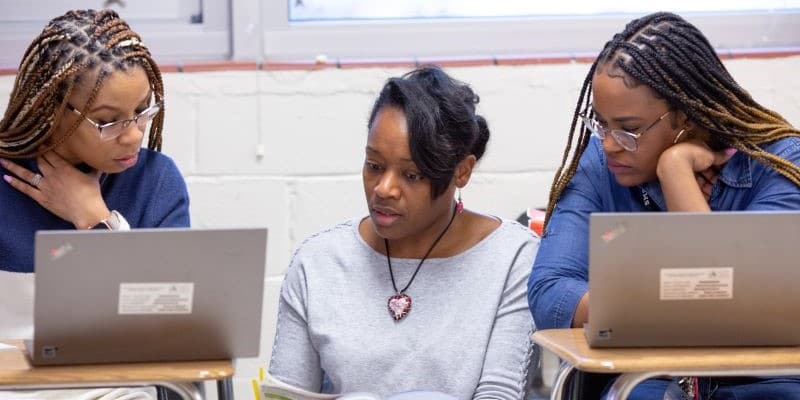Earlier this month, the Institute published data from our latest surveys of teachers and administrators. To my surprise, that data, collected in October 2021, suggests that teachers have declining interest in blended learning. That pattern in the data, however, contradicts what I’ve heard from others in the field about the use and adoption of blended learning that they’re currently seeing. So how does one make sense of these contradictory signals?
Early predictions of blended learning’s future
The COVID-19 pandemic forced massive school closures starting in March of 2020 and thereby spurred widespread adoption of technology across K–12 education. Of necessity, schools purchased devices and built out their broadband and hotspot connectivity to try to keep their students engaged online in learning while they were unable to meet in person. Additionally, as classrooms migrated to the cloud, teachers who may have never used technology in their classrooms before became acquainted with tools such as Google Classroom, Zoom, Kahoot!, and Pear Deck.
This forced adoption of technologies that serve as key components in blended learning models led me to predict in 2020 that overall blended-learning adoption would accelerate as a result of the pandemic. I didn’t expect a massive and widespread adoption of blended learning given the Institute’s research on the rigidity of organizational models and practices. I also worried that there would be some backlash against blended learning and educational technology post-pandemic due to the bad experiences of many students and teachers as they struggled to carry on with school under the limitations of hastily-implemented online learning tools.
Nonetheless, I did expect that the widespread exposure to online learning would lead at least some teachers who experienced benefits with its implementation to keep using the tools they discovered during the pandemic. This continued use, therefore, would lead to an overall uptick in the adoption of blended learning post-pandemic when compared to pre-pandemic adoption.
Data we collected in an earlier round of our survey in April and May of 2021 seemed to confirm my prediction. In that survey, we asked teachers about their use of the various blended-learning models at a few different points in time: pre-pandemic, at the time of the survey, and planned use post-pandemic (see Figure 9 below).

Although most teachers who were using the various models planned to use them less after the pandemic than at the time of the survey, they planned to use blended-learning models more post-pandemic than pre-pandemic. Teachers’ use of specific online learning tools also reflected this pattern, and many teachers commented in the free-response section of the survey about the blended-learning tools and practices they had found helpful and that they planned to keep using post-pandemic.
Discouraging signals in the latest data
To my surprise, the data from our Fall 2021 survey painted a different picture. Teachers’ planned use of the various blended-learning models post-pandemic was much lower than in the Spring 2021 survey data.
Whereas 19% of teachers who responded to the spring survey said that they planned to use a Station Rotation model post-pandemic, that number dropped to 15% in the fall survey. For the Flipped Classroom model, the decline in planned post-pandemic use was even more stark: from 18% in the spring to just 9% in the fall. Most of the other models saw similar declines in planned post-pandemic use across surveys: 13% to 7% for Individual Rotation, and 13% to 3% for Flex. Only Lab Rotation, which had very low adoption overall at all points in time, saw a slight projected increase in post-pandemic use between the two surveys, but the differences are small enough that they could be due more to random chance in how the survey data was collected than to any actual difference in what’s happening in the field.
The next graph below shows the data from both rounds of survey data collection side-by-side.

Reconciling contradictory anecdotes
As I’ve shared the latest survey data, I’ve heard news that is encouraging for blended learning yet contradictory with what our survey data suggests. Colleagues from Getting Smart, Ready to Blend, and The Modern Classrooms project have said that they’re seeing major increases in blended-learning interest from the schools and educators they work with.
So how do we make sense of the contradictions between nationally-representative survey data and anecdotal examples? I don’t have a definitive answer, but here are a few hypotheses:
Hypothesis 1: Blended learning is gaining increased traction in many schools and classrooms, but that trend is too small to show up in our nationally-representative data. Because Getting Smart, Ready to Blend and the Modern Classrooms Project support schools and educators with implementing blended learning models, they’re likely to be the first to notice increased interest in blended learning from the field. Yet in a country with 13,000 school systems, increased interest in blended learning among tens or even hundreds of schools is just a small drop in the bucket at the national level.
Hypothesis 2: Flaws in the design of our survey mean that the survey didn’t get an accurate picture of blended-learning adoption. In other words, when respondents said they had used or planned to use particular blended-learning models, their responses may not reflect actual adoption of blended-learning models in the way we would count adoption; and therefore, give an inaccurate picture of actual adoption. Some of our survey data points to this as a potential problem. For example, in the Fall survey, our definition of the Flex blended learning model included the following statement: “Students move on a flexible, fluid schedule through their learning activities according to their needs and preferences.” This statement implies that students don’t progress at a uniform pace within their courses. Yet among teachers who said they were currently using the Flex model, 39% also indicated on the survey that “All students move through lessons and assignments at the same pace.” This contradiction suggests that some teachers who indicated that they were using a Flex model weren’t actually using a Flex model as the Institute defines it. And if this kind of inaccuracy showed up in the data on current use of blended-learning models, the data on planned post-pandemic use may also be suspect.
In the spirit of Clayton Christian’s motto of “anomalies wanted” I’m eager to share our data and my reflections with those of you who read this blog. I’m also eager to hear what you’re observing in your own work that can add to the picture painted by the survey and anecdotal data I’ve described above. Finally, I’m eager to hear your hypotheses for making sense of these apparent contradictions. If you have additional information or insights to share, please comment below or reach out to me on Twitter (@ArnettTom) or via email (tarnett@christenseninstitute.org).
Photo by Allison Shelley for EDUimages.



